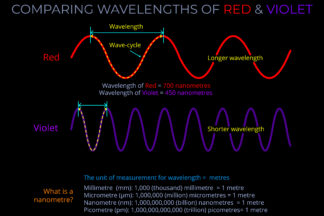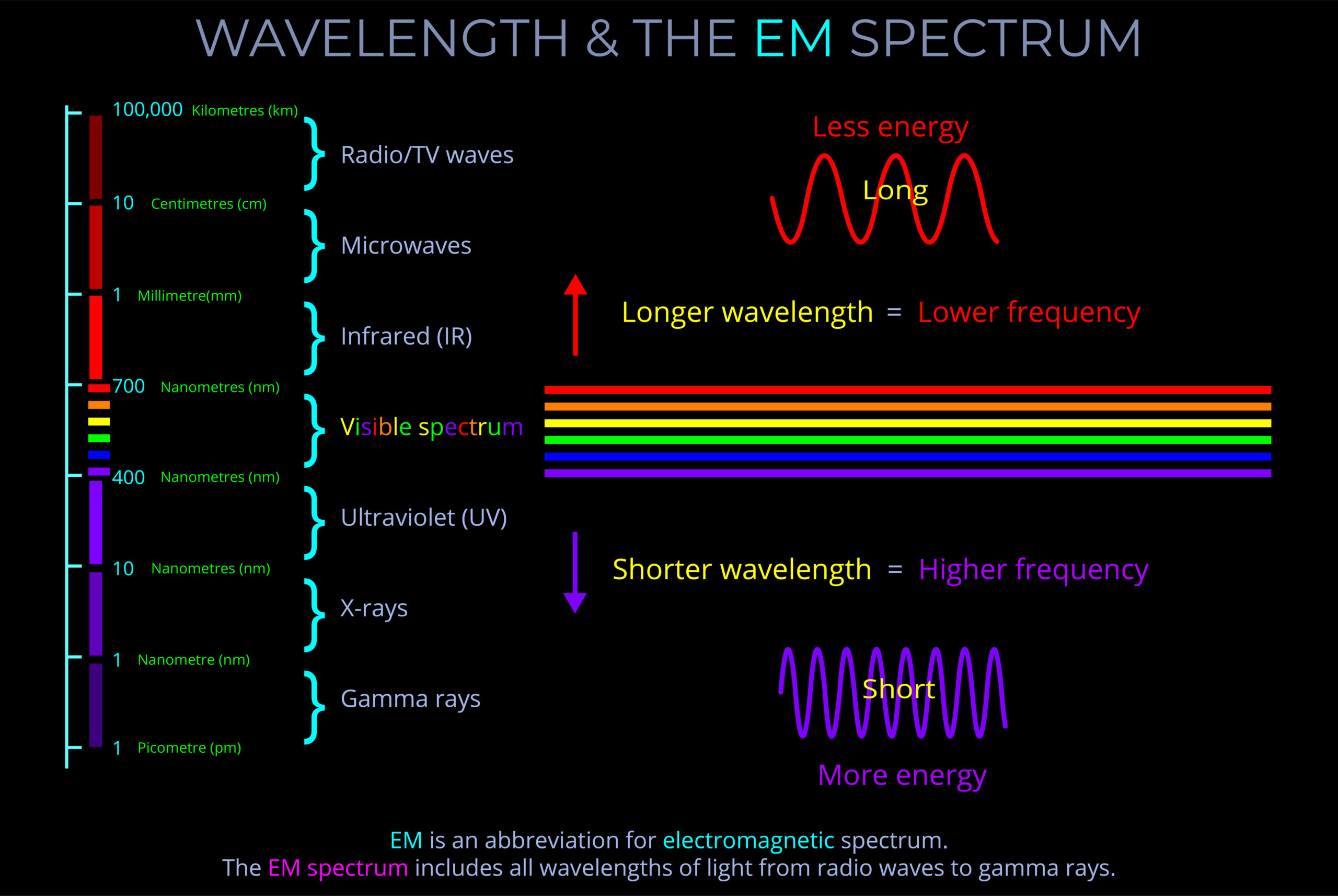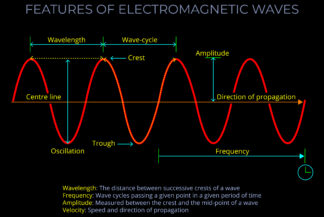Long Waves to Short Waves
£0.00
This diagram shows six electromagnetic waves. Each wave corresponds with a colour within the visible spectrum that an observer might recognise.
Remember that:
- Electromagnetic waves, which are a form of electromagnetic radiation, propagating from a light source, travel through space and encounter different materials.
- Colour is not a property of electromagnetic radiation, but an aspect of visual perception.
- A human observer can distinguish between colours corresponding with many thousands of wavelengths of light in the visible spectrum. These colours are often called spectral colours.
- The largest part of the electromagnetic spectrum is outside the wavelengths of visible light and so invisible to a human observer.
- Beyond red are infrared, microwaves and radio waves for example. Some radio waves have a wavelength longer than a kilometre (1000 metres).
- Beyond violet are ultraviolet, X-rays, and gamma rays for example. Some gamma rays have a wavelength of one billionth part of a metre.
- There are no properties of electromagnetic radiation that distinguish visible light from other parts of the electromagnetic spectrum.
- Objects appear to be different colours to an observer depending on the wavelengths, frequencies and amplitude of visible light at the moment it strikes the retina at the back of the eye.
Description
Long Waves to Short Waves
TRY SOME QUICK QUESTIONS AND ANSWERS TO GET STARTED
About the diagram
About the diagram
This diagram shows six electromagnetic waves. Each wave corresponds with a colour within the visible spectrum that an observer might recognize.
Remember that:
- Electromagnetic waves, which are a form of electromagnetic radiation, propagating from a light source, travel through space and encounter different materials.
- Colour is not a property of electromagnetic radiation, but an aspect of visual perception.
- A human observer can distinguish between colours corresponding with many thousands of wavelengths of light in the visible spectrum. These colours are often called spectral colours.
- The largest part of the electromagnetic spectrum is outside the wavelengths of visible light and so invisible to a human observer.
- Beyond red are infrared, microwaves and radio waves for example. Some radio waves have a wavelength longer than a kilometre (1000 metres).
- Beyond violet are ultraviolet, X-rays, and gamma rays for example. Some gamma rays have a wavelength of one billionth part of a metre.
- There are no properties of electromagnetic radiation that distinguish visible light from other parts of the electromagnetic spectrum.
- Objects appear to be different colours to an observer depending on the wavelengths, frequencies and amplitude of visible light at the moment it strikes the retina at the back of the eye.
Some key terms
ROYGBV are the initials for the sequence of colours that make up the visible spectrum: red, orange, yellow, green, blue, and violet.
- The visible spectrum refers to the range of colours visible to the human eye.
- White light, when passed through a prism, separates into a sequence of individual colours corresponding with ROYGBV which is the range of colours visible to the human eye.
- White light separates into ROYGBV because different wavelengths of light bend at slightly different angles as they enter and exit the prism.
- ROYGBV helps us remember the order of these spectral colours starting from the longest wavelength (red) to the shortest (violet).
- A rainbow spans the continuous range of spectral colours that make up the visible spectrum.
- The visible spectrum is the small band of wavelengths within the electromagnetic spectrum that corresponds with all the different colours we see in the world.
- The fact that we see the distinct bands of colour in a rainbow is an artefact of human colour vision.
Visible light refers to the range of wavelengths of electromagnetic radiation that is perceived as colour by human observers. While the range of visible light is generally considered to be 400-700 nm, the exact range of colours perceptible can vary slightly between individuals.
- Visible light is one form of electromagnetic radiation. Other forms of electromagnetic radiation include radio waves, microwaves, infrared, ultraviolet, X-rays, and gamma rays. Visible light ranges from approximately 400 nanometres (nm) for violet to 700 nm for red.
- A human observer perceives visible light as a combination of all the spectral colours between red and violet, as well as a vast range of other colours produced from the blending of different wavelengths in varying proportions.
The electromagnetic spectrum includes electromagnetic waves with all possible wavelengths of electromagnetic radiation, ranging from low-energy radio waves through visible light to high-energy gamma rays.
- There are no precisely defined boundaries between the bands of electromagnetic radiation in the electromagnetic spectrum.
- The electromagnetic spectrum includes, in order of increasing frequency and decreasing wavelength: radio waves, microwaves, infrared radiation, visible light, ultraviolet radiation, X-rays and gamma rays.
- Visible light is only a very small part of the electromagnetic spectrum.
Wavelength measures a complete wave cycle, which is the distance from any point on a wave to the corresponding point on the next wave.
- While wavelength can be measured from any point on a wave, it is often simplest to measure from the peak of one wave to the peak of the next or from the bottom of one trough to the bottom of the next, ensuring the measurement covers the whole of the cycle.
- The wavelength of an electromagnetic wave is usually given in metres.
- The wavelength of visible light is typically measured in nanometres, with 1,000,000,000 nanometres making up a metre.
- Radio waves, visible light, and gamma waves for example, each have different ranges of wavelengths within the electromagnetic spectrum.
The visible spectrum is the range of wavelengths of the electromagnetic spectrum that correspond with all the different colours we see in the world.
- As light travels through the air it is invisible to our eyes.
- Human beings don’t see wavelengths of light, but they do see the spectral colours that correspond with each wavelength and colours produced when different wavelengths are combined.
- The visible spectrum includes all the spectral colours between red and violet and each is produced by a single wavelength.
- The visible spectrum is often divided into named colours, though any division of this kind is somewhat arbitrary.
- Traditional colours referred to in English include red, orange, yellow, green, blue, and violet.
Visible light is the range of wavelengths of electromagnetic radiation perceived as colour by human observers.
- Visible light is a form of electromagnetic radiation.
- Other forms of electromagnetic radiation include radio waves, microwaves, infrared, ultraviolet, X-rays, and gamma rays.
- Visible light is perceived by a human observer as all the spectral colours between red and violet plus all other colours that result from combining wavelengths together in different proportions.
- A spectral colour is produced by a single wavelength of light.
- The complete range of colours that can be perceived by a human observer is called the visible spectrum.
- The range of wavelengths that produce visible light is a very small part of the electromagnetic spectrum.
The visible part of the electromagnetic spectrum is called the visible spectrum.
- The visible spectrum is the range of wavelengths of the electromagnetic spectrum that correspond with all the different colours we see in the world.
- As light travels through the air it is invisible to our eyes.
- Human beings don’t see wavelengths of light, but they do see the spectral colours that correspond with each wavelength and colours produced when different wavelengths are combined.
- The visible spectrum includes all the spectral colours between red and violet and each is produced by a single wavelength.
- The visible spectrum is often divided into named colours, though any division of this kind is somewhat arbitrary.
- Traditional colours referred to in English include red, orange, yellow, green, blue, and violet.
An electromagnetic wave carries electromagnetic radiation.
- An electromagnetic wave describes electromagnetic radiation as it propagates from a light source, travels through space and encounters different materials.
- Electromagnetic waves can be imagined as synchronised oscillations of electric and magnetic fields that propagate at the speed of light in a vacuum.
- Electromagnetic waves are similar to other types of waves in so far as they can be measured in terms of wavelength, frequency and amplitude.
- We can feel electromagnetic waves release their energy when sunlight warms our skin.
- Remember that electromagnetic radiation can be described either as an oscillating wave or as a stream of particles, called photons, which also travel in a wave-like pattern.
- The notion of waves is often used to describe phenomena such as refraction or reflection whilst the particle analogy is used when dealing with phenomena such as diffraction and interference.



